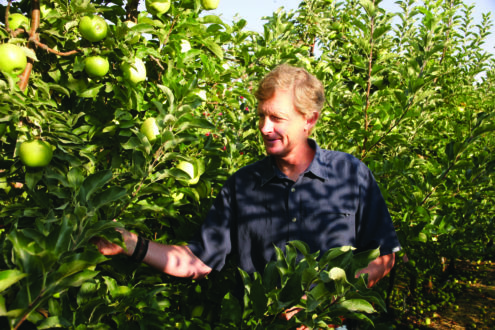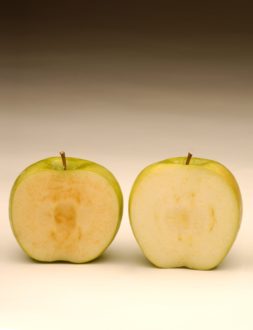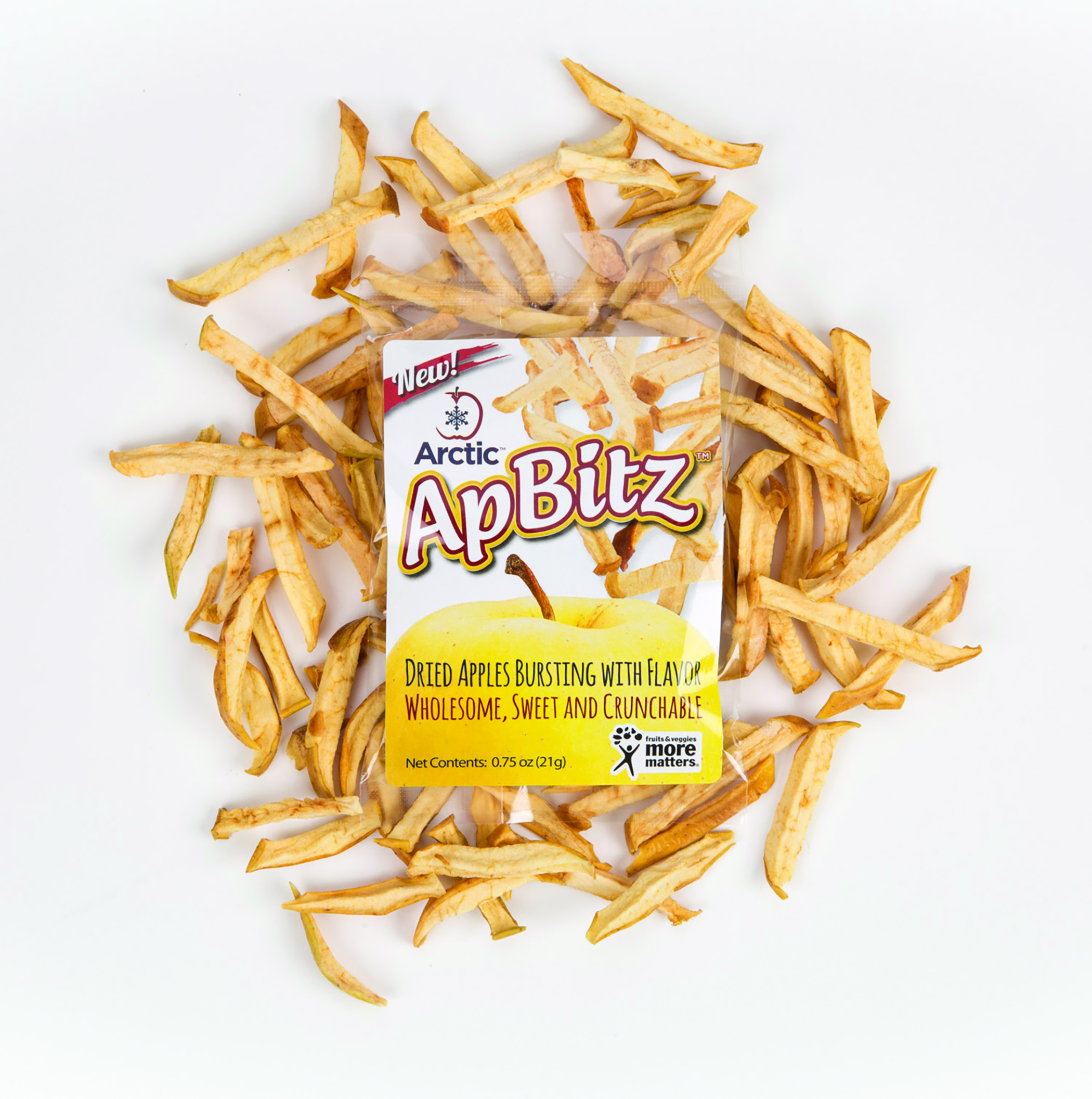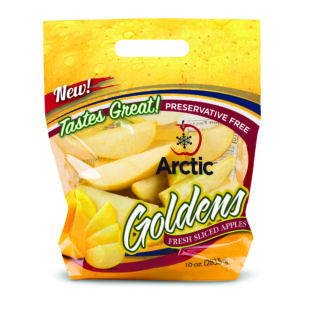

Aug 27, 2018Q&A with developer of the GMO non-browning Arctic apple
Genetically-modified Arctic apples don’t brown due to oxidation, a trait that U.S. consumers tried for the first time in the fall of 2017.
The trees that bear the apples remain unavailable for sale or distribution to growers, although owner Okanagan Specialty Fruits says the company is actively talking to growers and others in the industry. Genetically modified organism fruits are a relatively rare experience for consumers: The apples are just one of two GMO fruits approved by the USDA, with the other being papaya modified to resist disease.


Although apples debuted recently and they seem ground-breaking, they’ve been a long time coming. Based in British Columbia, Okanagan was founded in 1996 and proved the science behind Arctic apples in 2002. The apples were approved in 2015 by the USDA.
Now, Okanagan is continuing to work to improve Arctic apples and even develop other fruit products.
Neal Carter, president of Okanagan and himself an apple and cherry grower, recently participated in a question-and-answer session with Fruit Growers News about how far the company has come and where it is headed.
Fruit Growers News: Are growers and consumers ready for more genetically modified fruit crops?
Okanagan President Neal Carter: One of the biggest challenges we face not only at our company specifically, but within the whole agricultural biotechnology industry, is the misinformation that is out there regarding biotech foods. Our goal is to educate as many consumers as possible, including sharing that there is an extremely rigorous process that all biotech foods must satisfy before they can be freely grown and sold. We have found in our experience that transparency and enabling the public to experience Arctic apples firsthand are very impactful in educating consumers and gaining their support, especially when they discover the benefits biotechnology can offer.
FGN: How would you summarize the market reaction so far?
Carter: Although our company has been around for quite some time now, this past fall was actually the very first time our non-browning Arctic Golden apple slices were available commercially. The response by consumers really does echo the many years of consumer research we conducted; consumers continue to love the idea of non-browning apples and the convenience they deliver, as well as the superior eating experience of Arctic apples.
FGN: Are you able to share any sales figures?
Carter: We were very pleased with the reception and the consumer response data generated by these initial sales. The volume from the 2017 harvest was limited to 170,000 pounds, though our harvest in 2018 will be much larger. We’re busy in the orchard planting more trees so that we can expand our fresh market presence following the fall harvest of 2018 and we expect to expand availability across the U.S. and Canada in due course.
FGN: Have consumers bought them as eating or slicing apples?
Carter: This past fall, our Arctic Golden apples were exclusively available in 10-ounce grab-and-go bags of fresh-cut apple slices. The packaging highlights our apples’ unique non-browning trait, which enables Arctic apples to be preservative-free, and provides consumers with the convenience factor they desire and an unparalleled eating experience. Since Arctic apple slices don’t require any anti-browning treatments, any potential off-tastes that may come with them are avoided and we’ve found in taste tests the majority of consumers prefer the eating experience of Arctic Goldens over other sliced apple brands.
Earlier this year we released our new Arctic ApBitz dried apple snacks which are also preservative-free and just as healthy and delicious as our fresh slices. Plus, we’re excited to have the ability to highlight our unique non-browning trait in another way. They’re currently available on Amazon and we’ve received rave reviews from customers about their crunch and sweetness.


Coming this fall, we will also be offering whole Arctic Golden apples in a two-pound grab-and-go bag, in addition to 10-ounce bags of fresh sliced Arctic Granny and Arctic Golden apples.


FGN: In the first few years, do you think Arctic has done everything it can do, or is there still some untapped potential?
Carter: We definitely know we still have a lot to learn and many opportunities to explore. We plan to continue developing other apple varieties, create new apple products, explore the foodservice industry, research the implementation of our non-browning technology into other produce and apply for regulatory approvals in other countries. We certainly hope this is the just the beginning for us.
FGN: How many acres does Okanagan have planted right now?
Carter: All of our Arctic apple trees are grown in Washington state. We’ve been extremely busy in the orchard rapidly planting more trees so that we can expand our fresh market presence. We anticipate that we’ll have approximately 660 acres of Arctic apple trees planted at the end of this year and that number will increase to over 2,000 acres by the end of 2020.
FGN: Has there been outside interest from other growers in Arctic apples?
Carter: Yes, we do receive regular inquiries from growers interested in Arctic apples. However, we’ve opted to maintain control of Arctic apples from planting through to selling apples and value-added Arctic apple products.
FGN: Why have you kept the trees in-house, so to speak, so far?
Carter: For the time being we’ve been able to acquire enough acreage to support our business goals. But we aren’t ruling out the possibility of working with growers in the future, particularly with growers who are interested in growing apples for us.
FGN: Would it be possible to make Arctic a club variety, a la SweeTango?
Carter: Early in our company’s history, we explored the club variety model. Instead, with the support of our parent company, we’ve opted to become a vertically integrated company, all the way from the technology to being able to deliver our products to consumers.
FGN: In speaking to other apple growers so far, what are their most common questions to you?
Carter: Growers are interested in how they can benefit from the biotechnology behind Arctic apples and where the value of the non-browning trait can be realized. As we’ve often stated, there is value at every point in the supply chain so that more of the apples that are grown will make it to market. Superficial browning that results in downgraded fruit, even though there is really nothing wrong with the apples, is no longer an issue with Arctic varieties. With Arctic apple varieties, we are able to produce higher quality apples with less waste because of our non-browning trait.
FGN: Do you have any other R&D fruit or vegetable projects that you can tell me about?
Carter: We have done some preliminary work with other crops such as pears and cherries. While these projects are promising, they will be several years away. Our primary focus will remain on developing other Arctic apple products and new non-browning varieties.
– Stephen Kloosterman, FGN Associate Editor
Top Photo: Okanagan Specialty Fruits President Neal Carter picks an Arctic apple. Photos: Okanagan














